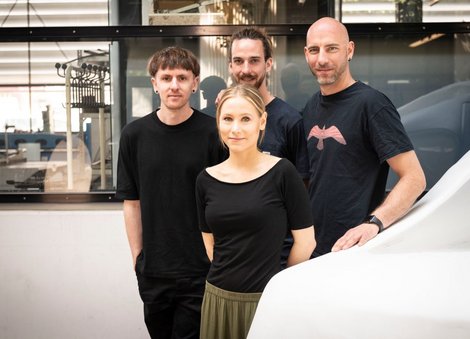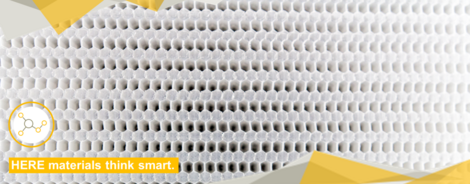All About Making

Embracing the new: Anhalt University of Applied Sciences has founded its Materiability Lab
Thinking ahead of the times, whatever the times: Anhalt University of Applied Sciences is an example of how innovative Saxony-Anhalt is in its research, development and opportunities for young people. The Materiability Lab opened at the start of this year right next to Walter Gropius’s historical Bauhaus building. Just like the upheaval seen during Gropious’s time, the lab is also venturing into new territory with its work, which includes experiments with smart and biobased materials. Prof. Manuel Kretzer, founder of the Materiability Research Group and Head of the lab, explains exactly what goes on there.
The Design Faculty has opened a new lab. What kind of workshop is it?
Prof. Manuel Kretzer: It’s not your typical workshop. This lab is something completely new. It’s an experimental laboratory that is helping to advance the established materials-based activities of the Architecture and Design faculties by taking them to a new level. It is fitted with tools and machines for advanced materials production and digital manufacturing. Our focus is on new materials, new approaches and, in particular, a new way of working. Our work here is experimental and we try lots of things out. We experience new technologies and materials in a playful design context. Part of that is not necessarily knowing what the end result will be when you start out. We can approach our projects freely and with an open mind. The lab reflects the fundamental ideas of my previous work and research: transdisciplinarity, openness and exchange. These qualities allow you to immerse yourself in unfamiliar disciplines in order to gain a certain level of understanding and a common vocabulary. If we work together with experts from other disciplines early on, we can create much more concrete, pioneering and sustainable solutions.
What smart and biobased materials do you work with?
When teaching the basic principles of smart materials, we often focus on topics such as thermochromic materials – i.e., materials that can change their color – because they are readily accessible and easy to use. When doing research and teaching students further on in their course, we are increasingly dealing with biomaterials, in particular from the perspective of sustainability. These materials include different kinds of algae, mycelium and even kombucha mushrooms, which when dried can be used to make a vegan material with leather-like properties. Throughout all this, we use state-of-the-art technology such as 3D printers or high-precision laser cutters. We currently have a PhD student who is researching 3D printing with bioplastics. We are trying to develop a material that, unlike most filaments available now, is biodegradable. We are also investigating whether the material properties themselves can be dynamically changed. It’s not unreasonable to think that we might be able to create a hybrid materiality with characteristics ranging from firm to soft or transparent to opaque.
How does that work on a practical level – who approaches you to do research and development at the lab?
We cover a wide spectrum, teach the fundamentals, experiment with materials, and our students learn about different digital design and manufacturing processes. Bachelor- and master-level projects are underway at our lab, and PhD and master’s students are writing their final dissertations on the work they’re carrying out here. We also collaborate with industry partners. Last semester, for example, we developed generatively designed furniture for a Swedish 3D printer manufacturer who builds machines on a large scale and printed our designs on a 1:1 scale.
Do smart materials have a promising future?
Lots of smart materials have been around for a while but we still have a long way to go to unlock their full potential. The biggest challenges are finding more fields of application, increasing awareness of dynamic and adaptive applications and engaging individual research disciplines in closer dialogue so that we can become better at recognizing demands and finding common solutions. Rather than just individual, isolated smart materials, I think that we will soon have lots of hybrid solutions that will connect different technologies, ensuring greater transformations.
There are currently lots of changes taking place in the automotive sector in Saxony-Anhalt, particularly in terms of construction and materials. Is the lab working on these areas?
We have collaborated with Audi on several occasions and looked at sustainability and a new biologically inspired design language. We tackled future-oriented topics such as the design of autonomous vehicles. One issue was the interior fittings – if the car can drive itself, the passenger is free to do other things. We put our experiences in digital design to good use in these projects and drew inspiration from nature for our generative and parametric processes. That’s how we can create designs that allude to nature.
How important do you think smart materials are in the automotive sector?
I think that it is imperative to use smart materials in many sectors, including in the car industry. As part of our last collaboration with Audi on the Adaptive City Car, we produced a 1:1 prototype using robots and looked at issues such as autonomous driving, car sharing and what our future relationship with cars will be. If, in the future, people in urban areas in particular no longer own their own car but rent or send for a car when they need one, smart materials and systems can help us to connect with an anonymous vehicle by allowing it to automatically adjust to our individual needs and preferences. That might be as simple as the car changing to our favorite color or welcoming us by playing our favorite music. Of course, the question of sustainability is especially important for research and development in the automotive sector. We tried to make our project more sustainable by integrating moss in the vehicle exterior that would not only filter and clean the air entering the interior, filling it with oxygen, but also bring some vitality and nature back into the city.
What is the lab planning on doing next?
Everything is currently still in development; we are in the process of expanding the project, our research group is growing and we have received external funding. We have been given financial support from the Investment Bank of Saxony-Anhalt with funds from the ego.-INKUBATOR. We plan on pursuing the ideas that start here and we may well found spin-offs and ready our products for the market.
“Materiability is about making” – does this slogan on your website still hold true?
Sharing information has always been a fundamental part of my work and research. We don’t mystify anything here: our approach encourages initiative and independence and we guide others in their self-learning and self-understanding. We operate an open-source philosophy and we make our findings freely available for everyone online. We hope this will help connect creative disciplines with scientific disciplines, design with research – so yes, there’s still so much more we want to do!
Author: Manuela Bock/IMG Saxony-Anhalt

One can rightly claim that Saxony-Anhalt is an innovative commercial and scientific site for smart materials. Here, innovations for the global market are created with entirely different approaches. HERE materials think smart.
